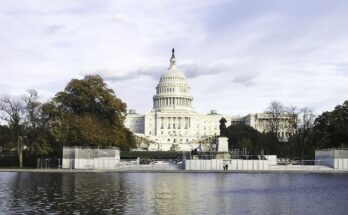The rubble of Gaza City is not just made up of stones and walls. “These ruins are now witnesses to our pain,” Doaa Ulyan, 38, says in a raucous audio message sent from the Palestinian lands where he spent his childhood and youth. Despite all the difficulties brought by the Israeli occupation and the blockade in force since 2007, Ulyan had built “a happy life”. He loved his work in a World Bank-funded development program. He had a light-filled house from which he could glimpse the Mediterranean Sea and where he lived with his two sons, Rezeq, 14, and Abdul, 10, who went to school and played football.
They all managed to survive these two years of Israeli military offensive. But of the life they had before, Ulyan whispers, only “ashes” remain.
The attacks destroyed the landscape he once knew. Their neighbourhood, Al Rimal, the jewel in the crown of the Gaza capital for its cultural dynamism, schools and skyscrapers, is reduced to rubble. On September 5, the Israeli army blew up Mushtaha Tower, the tallest building in Gaza, which was on the same street as Ulyan’s house before it too was destroyed in an attack. More than 53 million tons of ruins now cover an area where everything is grey.
“If you destroy the city, you destroy the living conditions of its inhabitants. Not only in a biological sense, but also culturally. It’s an indirect way of killing,” architect Eyal Weizman says by phone from London. He is the founder and director of Forensic Architecture, and describes “a slow death” caused by these other “less spectacular” methods than “shooting, bombing and starvation”.
It is also possible to kill by destroying what allows a population to survive. “Human beings are like mussels without shells. Our shells are the homes, hospitals, institutions and infrastructures we must build to sustain life,” continues the architect. “We know that 40% of dialysis patients in Gaza have died because there are no hospitals,” he says.
The official list of the dead in the Gaza Strip exceeds 68,000 names. According to United Nations data, another 11 thousand corpses remain under the rubble. But many other victims, like the dialysis patients mentioned by Weizman, are invisible.
Israel didn’t just kill. It has also erased the landscapes that allow people to recognize their history, to place their memories in the right frame. “They destroyed almost everything. There is no longer any place to keep our memories,” laments Doaa’s sister, Malak Ulyan, 32, from her new home in Granada, southern Spain.
Malak remembers one of the places from her childhood that the Israeli offensive took away from her. “It was called Al Baqa (Bouquet of Flowers) and it was a dam that extended several meters into the water. It was shaped like a huge boat.” He recalls how the children of Gaza loved “that feeling of sailing on a big ship” on the high seas, a feeling they could only imagine given that the Israeli blockade prohibited such ships from landing on their shores. Israel has only allowed small fishing boats to enter this area of the Mediterranean, requiring them to stay a short distance from the beach.
Scorched earth
Israeli attacks have transformed the lands of thousand-year-old Gaza – a territory that, according to Weizman, has hosted a succession of cultures for more than 5,000 years – into a clean slate “Where it is not possible to distinguish between highways and sidewalks, between private and public, between agricultural and urban,” describes the architect. “Everything has become like the surface of the Moon, an indistinct desert, something that is no longer describable”.
In August, before Israel’s latest invasion of the capital of Gaza in September, ahead of the ceasefire that took effect on October 10, Google Maps updated its satellite images of Palestinian lands. Not even the expression “scorched earth” can accurately describe it: aerial shots of at least 92% of its housing stock destroyed and damaged (according to United Nations data). All the universities have been bombed or blown up, and eight out of ten streets have disappeared or are unusable.
Weizman does not use the term “urbicide” (the deliberate destruction of a city) to describe this devastation. Instead he talks about genocide. Lebanese urban planner Soha Mneimneh, on the phone from Beirut, agrees. “Urbicide is yet another phase of genocide. The risk lies in focusing too much on the destruction of buildings and not on that of people,” he says.
Malak Ulyan has not only lost the beloved places of his childhood in this war, such as the Al Baqa wall, Palestine Street, which he took to go to school and which Israeli tanks destroyed on September 30. Above all, the bombs took the lives of three of her teenage cousins – “I will never forget them,” she repeats – as well as the friends she grew up with.
He lists their names: Nesma and her sister Haya, the “very close” Israa and Nora. “Nora,” Malak says with difficulty, was a “dear smiling girl, who had a heart as pure as water.” As a teenager, Nora secretly left a cell phone with her at their high school, Al Rimal, which was also partially destroyed in a bombing.
A key, a perfume
Even the smell of Malak’s childhood is now just a memory, that of jasmine and saffron planted in the gardens of the “small and silent” houses on Al Nasr Street in Gaza City. His maternal grandparents lived in one of them. His grandfather kept a treasure: the key that opened the door to the family home in Wadi Hunayn, in the center of what is now Israel.
In 1948, at the beginning of the Palestinian exodus, the Jewish militias that preceded the Israeli army destroyed the city and expelled its inhabitants. The Ulyans’ grandfather was one of the 200,000 Palestinians who took refuge in Gaza. That same year, 750,000 people fled or were expelled from their lands during the Nakba (meaning “catastrophe”), the original sin of Israel’s creation. In the offensive that began in October 2023, the Israeli army destroyed the Ulyans’ grandparents’ house, their jasmine plants and their orange trees.
Israel is now applying the same Nakba model of “ethnic cleansing and destruction” in Gaza, says Mazin Qumsiyeh from Bethlehem, West Bank. She is a biologist and director of the Palestine Institute for Biodiversity and Sustainability. “You cannot colonize without ecocide, without genocide, without urbicide,” says the professor. To take over “the land” it is necessary to “kill the indigenous population” and build a new one “in the image of the colonizer (the Israelis)”, says Qumsiyeh. “War is also an architectural question,” Weizman insists, because “it destroys and reshapes at the same time.”
Destroy to rebuild
Salman Abu Sitta is 88 years old. He was 10 years old when a group of European Jews – he gives some of their names, a Russian, a Ukrainian, a German – from the Haganah militia razed his town of Maeen Abu Sitta, “about two or three miles from the border wall” that now encloses the Gaza Strip and which did not exist at the time. The engineer and historian, who dedicated his life to reconstructing the memory of Palestine, became a refugee from Gaza.

Those armed European men, Abu Sitta recalls, destroyed the landscape of his town, setting it on fire and razing its homes and the school his father had built. They would later build on the site where the Palestinian community was located. Four of the kibbutzim attacked by Hamas on October 7, 2023 were located on lands looted by the Abu Sitta family. The historian believes that, similarly to what happened during the Nakba, with its attack on Gaza, Israel seeks to “destroy the Palestinian people, their memory and their identity”. So far this crusade has been unsuccessful. “I will never forget my homeland,” he says.
In Gaza, Israel has invented a new kind of destruction, Weizman says. “I call it uprooting, or rootless destruction,” he says, meaning “using an excavator, digging the shovel into the ground and razing everything above and below the surface.”
This also happened in cemeteries. Malak and Doaa’s grandfather was buried with his wife in the Sheikh Redwan cemetery in Gaza, which is one of the burial sites that Israel has bombed, in some cases even driving bulldozers over the graves. The Ulyan sisters do not know what became of their grandparents’ grave.
“The city is also a place of memory,” says Weizman, and cemeteries “maintain our relationship with the past, with our ancestors.”
In Gaza the past is long. The Palestinian lands, Weizman says, have been “continuously inhabited for 5,000 to 9,000 years.” “If you dig anywhere on the coast, you’ll find archaeological remains. It’s like a linear archaeological site,” he notes.
The territory was populated by Canaanites, Philistines, Assyrians, Babylonians, Persians, Egyptians, Greeks and Romans before becoming part of the Umayyad, Abbasid and Fatimid caliphates and, finally, the Ottoman Empire and the British Mandate of Palestine. Herodotus mentions Gaza as early as 4th century BC Alexander the Great and Napoleon passed through the area.
On September 14, the Euro-Med Human Rights Monitor organization stated that Israel is “deliberately targeting historical, archaeological, religious and cultural sites in Gaza, particularly in Gaza City,” in an attempt to “erase the material and spiritual symbols of the Palestinian people.” According to UNESCO, at least 110 historic sites have been destroyed or damaged.
Weizman is not optimistic about plans for their reconstruction. The strategic goal “of this genocide was to expel the Palestinians from Gaza,” he says, something Israel “failed to achieve during this war.” There is also an ongoing attempt to create concentration camps in the South,” he says. Weizman believes that these reconstruction plans “could be the continuation of genocide through other means.”
“Construction companies will say they can’t work with people on these sites. So they will concentrate the population in certain places. All the plans I’ve seen for rebuilding Gaza are based on the footprint of destruction,” Weizman says.
At the moment, US President Donald Trump’s ceasefire has allowed Israel to gain military control of 58% of the Gaza Strip. Palestinians cannot enter this space, which occupies more than half of what was once Gaza. If they do, they are shot. More than two million people are now crammed into the remaining 42 percent, living among the ruins.
Sign up to our weekly newsletter to get more English-language news coverage from EL PAÍS USA Edition



